Llan Ffestiniog, also known as Ffestiniog or Llan, is a village in the ancient county of Merionethshire, which lies south of the more recent town of Blaenau Ffestiniog. The men of the village who fell during both World Wars are commemorated on the Llan Ffestiniog War Memorial, which is located in a memorial garden at the junction of the A4212 and B4391 roads through the village. It was unveiled on 11 September 1920 in a ceremony attended by Lady Newborough, whose husband had died in WW1.
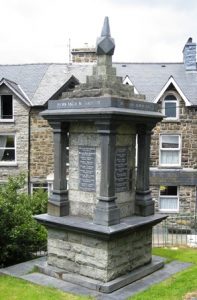
The Great War, 1914-1918
John William Black, Lance Corporal, 290432, Royal Welsh Fusiliers. John was born in Hammersmith, the son of Thomas Casey Black and Winifred Black (nee Jones). His mother was originally from Maentwrog, and by 1911 had moved to 10, Tyn-y-Maes, Ffestiniog, while John was living at 27, Jones Street, Blaenau Ffestiniog, where he worked as a slate quarry labourer. John enlisted at Blaenau Ffestiniog into the 7th Battalion, Royal Welsh Fusiliers on 5 July 1911. He attended the annual Territorial camps at Lamphey, Caernarvon, Rhyl and Aberystwyth over the next four summers. The battalion which mobilised for war at Newtown in August 1914, as part of North Wales Brigade, Welsh Division and moved to Conway until the end of the month, before moving to Northampton. In December the Division moved to Cambridge and then in May 1915 to Bedford, where the Division was numbered and the formation became 158 Brigade, 53rd (Welsh) Division. On 19 July 1915 the entire Division sailed from Devonport for Imbros and on 9 August 1915 landed at Suvla Bay. The Division became embroiled in heavy fighting over the coming days, then endured a terrible winter before being evacuated from Gallipoli in December 1915, moving to Egypt to join the EEF, and helped guard the Suez Canal before taking part in operations to drive the Turks out of the Sinai. The EEF then turned its attention onto driving the Turks out of Palestine, and on 26 March 1917 launched its first offensive against the coastal city of Gaza, which guarded the road to Jerusalem. The assault failed, and a second attempt was launched on 17 April which also failed. The EEF was then re-organised and gained a new commander in Sir Edmund Allenby before launching a third offensive on 31 October, along a broader front running from Beersheba to Gaza, which ultimately broke the Turkish lines, and opened the road to Jerusalem. John was killed in action during an assault by 158 Brigade against Khuweilfeh Hill on 6 November 1917, aged 26. He is buried in Beersheba War Cemetery, Israel.
David Robert Davies, Gunner, 174191, Royal Garrison Artillery. David was the son of Robert and Margaret Davies of Llainwen, Ffestiniog. He married Mary Ann Edwards in 1908 and the couple resided at Llainwen where their two children were born. David worked as a Quarry Man prior to enlisting at Liverpool into the Royal Garrison Artillery. He was posted to the 11th Siege Battery, RGA, and embarked for France with the battery on 18 June 1916. David was killed in action whilst the battery was in action at Ypres on 4 October 1917. The 35-year-old is buried in Ypres Reservoir Cemetery, Belgium.
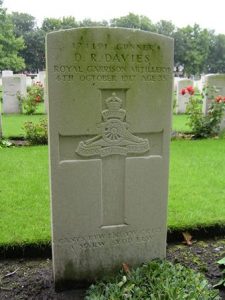
Robert Davies, Private, 290592, Royal Welsh Fusiliers. Robert was the son of William and Anne Davies, of Teilia Isaf, Ffestiniog. He worked as a Joiner prior to the war. Robert enlisted at Blaenau Ffestiniog into the 7th Battalion, Royal Welsh Fusiliers on 19 August 1914. The battalion was a Territorial unit, which mobilised for war at Newtown in August 1914, as part of North Wales Brigade, Welsh Division and moved to Conway until the end of the month, before moving to Northampton. In December the Division moved to Cambridge and then in May 1915 to Bedford, where the Division was numbered and the formation became 158 Brigade, 53rd (Welsh) Division. On 19 July 1915 the entire Division sailed from Devonport for Imbros and on 9 August 1915 landed at Suvla Bay. The infantry moved off the beaches into the bush, but due to a lack of maps and no knowledge of the terrain, many of the units became disorientated, and the situation became chaotic. Robert was struck in the chest by shrapnel on 11 August, and the lead ball exited above his heart. He was evacuated by Hospital Ship back to Netley Military Hospital for treatment, and upon recovering, was posted to Egypt on 6 July 1916, re-joining the 7th RWF. The 53rd Division had been evacuated from Gallipoli in December 1915, moving to Egypt to join the EEF, and helped guard the Suez Canal before taking part in operations to drive the Turks out of the Sinai. The EEF then turned its attention onto driving the Turks out of Palestine, and on 26 March 1917 launched its first offensive against the coastal city of Gaza, which guarded the road to Jerusalem. Initial gains during the day were lost when the assaulting divisions lost touch with each other and communication broke down when a thick fog cloaked the battlefield. A second, unsuccessful, attempt to force Gaza was launched on 17 April, and raged for two days. Robert was killed in action near Gaza on 20 April 1917, aged 27. He is buried in Gaza War Cemetery, Palestine.
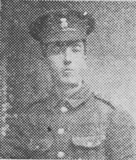
Thomas Davies, Private, 260071, Cheshire Regiment. Thomas was the son of David Davies, of Highgate, Ffestiniog. By 1911 he had moved to Treharris where he worked as a coal miner. Thomas had married prior to the war and then lived with his wife Maggie at 17, Park Row, Tredegar. He enlisted at Tredegar into the Monmouthshire Regiment, and after completing his training, was posted to the 11th Battalion, Cheshire Regiment. The battalion had landed in France on 26 September 1915, attached to 75 Brigade, 25th Division. The Division helped defend Vimy Ridge against a German attack in May 1916. It then moved to the Warloy area and attacked on 3 July near Thiepval. The Division fought throughout the Battle of the Somme, and then moved to Ploegsteert, where it held the line for the months leading up the Battle of Messines in June 1917. After fighting at Messines, the Division moved slightly north, and took part in the main Passchendaele offensive. On 12 September 1917 the Division began to move away from the Ypres Salient, and by 9 December had reached Bapaume, on the Somme, before taking over trenches near Lagnicourt. On the night of 12 March, the 11th Cheshire moved to Bihucourt, in case of an enemy attack. The Germans were busy building up and preparing to launch an offensive in this sector, and the soldiers holding the British line knew only too well that something was building up, due to the activity behind the German lines. Thomas was killed in action in the line here on 15 March 1918, less than a week before the Germans were to launch their offensive. The 32-year-old has no known grave and is commemorated on the Arras Memorial, France.
Robert Lloyd Edwards, Private, 26276, Royal Welsh Fusiliers. Robert was the son of Lizzie Edwards, of 8, Tyn-y-Maes, Ffestiniog. He worked as a Railway Porter for the Great Western Railway prior to the war. Robert enlisted at Blaenau Ffestiniog into the 17th Battalion, Royal Welsh Fusiliers on 3 July 1915. The battalion was raised at Llandudno, joining 128 Brigade, 43rd (Welsh) Division and trained in North Wales before moving to Winchester in the summer of 1915, where the formation became renumbered 113 Brigade, 38th (Welsh) Division. The Division moved to France on 2 December 1915 and moved to the Nursery Sector near Fleurbaix for trench initiation alongside the Guards Division. On 9 May 1916 the 17th RWF moved into the front line in the Moated Grange sector to begin a short four-day tour. At around 01.50 in the morning of 13 May 1916 the Germans detonated a mine near the line held by the 17th RWF, just as a patrol from the battalion was returning across No Man’s Land. The explosion killed ten men of the patrol, whilst wounding an officer and ten others. Robert was among the dead. The 20-year-old has no known grave and is commemorated on the Loos Memorial, France.
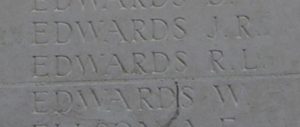
David Richard Ellis, Private, 291534, Royal Welsh Fusiliers. David was the son of Richard Owen Ellis and Mary Anne Ellis, of Bronant, Ffestiniog. He worked as a Railway Platelayer and then as a Storeman prior to the war. David enlisted at Blaenau Ffestiniog into the 7th Battalion, Royal Welsh Fusiliers on 19 February 1916 and was initially posted to Park Hall, Oswestry to join the 3/7th Battalion, Royal Welsh Fusiliers. He embarked at Devonport for Egypt on 6 September 1916, and on 24 September joined the 1/7th Battalion, Royal Welsh Fusiliers, which was on the Suez Canal defences attached to 158 Brigade, 53rd (Welsh) Division. The Division had been evacuated from Gallipoli in December 1915, moving to Egypt to join the EEF, and helped guard the Suez Canal before taking part in operations to drive the Turks out of the Sinai. The EEF then turned its attention onto driving the Turks out of Palestine, and on 26 March 1917 launched its first offensive against the coastal city of Gaza, which guarded the road to Jerusalem. Initial gains during the day were lost when the assaulting divisions lost touch with each other and communication broke down when a thick fog cloaked the battlefield. David was killed in action during the fighting that day. The 26-year-old is buried in Gaza War Cemetery, Gaza.
Edward Evans, Captain, Army Veterinary Corps. Edward was born at Beddgelert on 26 February 1877, the son of William Evans and Mary Evans (nee Jones). His mother was from Llan Ffestiniog, but later ran the Bull’s Head Hotel, at Bala. Edward was educated at Bala Grammar School and then trained as a Veterinary Surgeon at The Royal (Dick) Veterinary College, Edinburgh, qualifying MRCVS, before becoming Veterinary Inspector for Bala District, then Veterinary Inspector for Cerrigydruidion. Edward was commissioned into the Army Veterinary Corps in July 1915, and was later promoted to Captain before being posted to the 5th Divisional Train, Larkhill. His health began to suffer towards the end of 1915, but was passed as fit enough to continue serving in the army, before embarking for France in September 1916. He was invalided home on account of ill-health in April 1917 and treated at the 4th London General Hospital, before being sent home on leave to recuperate. He returned to duty at No. 7 Reserve Veterinary Hospital in Ormskirk, Merseyside, but his health continued to deteriorate and on 9th March he was admitted to Croxteth Hall Military Hospital for Officers. He died there of Bright’s Disease on 21 May 1918, aged 41. His remains were brought to Llan Ffestiniog and he was buried with full military honours with his mother, who had died in 1903. Edward is not commemorated on the Llan Ffestiniog memorial.
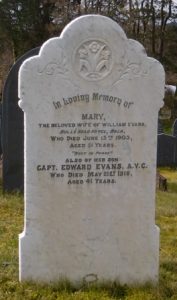
David John Jones, Private, 25913, Lancashire Fusiliers. David was the son of Richard and Jane Jones of Peniel Cottage, Llan Ffestiniog. He enlisted at Barmouth into the Royal Field Artillery, but was then transferred into the 15th Battalion, Lancashire Fusiliers. The battalion was attached to 96 Brigade, 32nd Division, and had landed in France on 22 November 1915. The Division took part in the Somme offensive the following summer, remaining in the area over the winter before taking part in the advance which followed the German withdrawal to the Hindenburg Line in March 1917. The Division captured Holnon Wood on 1 April, and then the village of Fayet two weeks later, before moving north and took part in Operations on the Flanders Coast. By the end of October, the Division had begun moving into the battle area in the Ypres Salient, taking over a section of the front near Irish Farm on 30 November. David was killed in action whilst on a working party near Irish Farm on 25 December 1917, aged 21. He is buried in Duhallow A.D.S. Cemetery, Belgium.
Evan Goronwy Jones, Private, 291313, Royal Welsh Fusiliers. Evan was the son of John Owen Jones and Winifred Jane Jones, of 9, Station Road, Ffestiniog. He worked as a Quarry Man prior to the war. Evan enlisted into the 3/7th Battalion, Royal Welsh Fusiliers at Blaenau Ffestiniog on 27 November 1915 and was posted to Park Hall, Oswestry for training. On 21 October 1916 he embarked for Egypt, joining the 1/7th Battalion, Royal Welsh Fusiliers, which was attached to 158 Brigade, 53rd (Welsh) Division. The Division had been evacuated from Gallipoli in December 1915, moving to Egypt to join the EEF, and helped guard the Suez Canal before taking part in operations to drive the Turks out of the Sinai. The EEF then turned its attention onto driving the Turks out of Palestine, and on 26 March 1917 launched its first offensive against the coastal city of Gaza, which guarded the road to Jerusalem. Initial gains during the day were lost when the assaulting divisions lost touch with each other and communication broke down when a thick fog cloaked the battlefield. A second assault against Gaza was launched on 17 April, but again failed, so the EEF was re-organised, with Sir Edmund Allenby taking command, before launching a third offensive on 31 October, along a broader front running from Beersheba to Gaza, which ultimately broke the Turkish lines, and opened the road to Jerusalem. Evan was killed in action during an assault by 158 Brigade against Khuweilfeh Hill on 6 November 1917. The 27-year-old is buried in Beersheba War Cemetery, Israel.
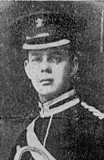
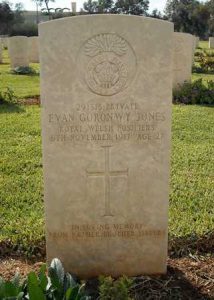
George Henry Jones, Private, 2637, Royal Welsh Fusiliers. George was the son of William and Jane Jones, of 5, Bodafor, Blaenau Ffestiniog. He enlisted into the 3/7th Battalion, Royal Welsh Fusiliers in 1915 and was posted to Park Hall, Oswestry for training. George took ill just a few months after enlisting, and died of heart failure at Park Hall on 25 April 1916, aged 21. His remains were brought home for burial in Llan Ffestiniog Cemetery. George is not commemorated on the Llan Ffestiniog memorial.
Ifor Jones, Saddler, 98569, Royal Field Artillery. Ifor was the son of Hugh and Ellen Jones, of Bron-Y-Graig, Ffestiniog. He enlisted into the Royal Field Artillery at Woolwich soon after the outbreak of war, and was posted to A Battery, 119th Brigade, Royal Field Artillery, which was attached to the 38th (Welsh) Division. Ifor landed in France with the Battery on 23 December 1915 and the entire Division moved to the Nursery Sector near Fleurbaix for trench initiation alongside the Guards Division. The Division held various parts of the line from here to Cuinchy over the coming months, before transferring to the Somme in June 1916 and from 7 July 1916 launched an assault on Mametz Wood. The Division had cleared the wood to its northern edge before being relieved on 12 July and took over a section of line at Hébuterne before being transferred to the Canal Bank sector, north of Ypres, remaining there until taking part in the Battle of Pilckem Ridge on 31 July 1917 and also in the ensuing Battle of Langemarck. The Division then transferred to the Lys sector, near Armentieres for the winter, but at the end of March 1918 was sent to the Somme to relieve the battered 2nd and 47th Divisions in the line facing Bouzincourt Ridge. The Divisional artillery remained, for now, in the Armentieres sector, where it became caught up in heavy fighting following the German offensive on the Lys from 9 April 1918. Ifor was wounded during heavy fighting near Mount Kokereele, near Bailleul, and died of his wounds on 17 April 1918, aged 20. He is buried in Morbecque British Cemetery, France.
Joseph Jones, Pioneer, WR/300626, Royal Engineers. Joseph was the son of Owen and Fanny Jones, of Rose Hill, Belle View, Ffestiniog. He had worked as a Labourer prior to enlisting at Ffestiniog into the 4th Battalion, Royal Welsh Fusiliers (Militia) on 25 November 1905. He then enlisted into the He served with both the 1st and 2nd Battalions, Royal Welsh Fusiliers over the coming years prior to the war and had spent six years in India with the Regiment. Joseph embarked for France with the 2nd Battalion, Royal Welsh Fusiliers soon after the outbreak of war. He served with the battalion on the Western Front for almost three years before transferring to the Inland Waterways and Docks, Royal Engineers, but his health had broken down during the war and on 2 September 1918 Joseph was discharged as medically unfit, returning home to Ffestiniog. He died of tuberculosis on 1 April 1920, aged 40, and is buried in St. Michael’s Churchyard, Llan Ffestiniog.
Morris Jones, Private, 25269, Royal Welsh Fusiliers. Morris was the son of Richard and Jane Jones, of Peniel Cottage, Ffestiniog. He worked as a Quarryman prior to the war. Morris had married Jane Anne Jones on 21 November 1914, a year after the birth of their first daughter, and the couple lived at 2, Glasfryn, Ffestiniog. He enlisted at Blaenau Ffestiniog into the 17th Battalion, Royal Welsh Fusiliers on 12 April 1915. The battalion was raised at Llandudno, joining 128 Brigade, 43rd (Welsh) Division and trained in North Wales before moving to Winchester in the summer of 1915, where the formation became renumbered 113 Brigade, 38th (Welsh) Division. The Division moved to France on 2 December 1915 and moved to the Nursery Sector near Fleurbaix for trench initiation alongside the Guards Division. Morris hurt his knee a month later and was evacuated to hospital at Rouen, before re-joining the 17th RWF on 27 February 1916. The Division then held a sector of the line near Cuinchy before marching south to the Somme sector in June 1916 to take part in the assault on Mametz Wood. The first attack on the wood was launched on a two-battalion front on 7 July, but failed, and the Divisional Commander, Sir Ivor Philipps, was replaced before the Division attacked again on a two Brigade front on 10 July 1916. By the time it was relieved on 12 July the Division had cleared the wood up to the north boundary. It then held a section of front at Hébuterne for a month before taking over the Canal Bank sector at Boesinghe, north of Ypres. On 31 July 1917 the Division launched an assault against the Pilckem Ridge, taking its objectives of the ridge and reaching the Steenbeek. Part of the battalion went into reserve, while several battalions took part in the ensuing Battle of Langemarck. On 29 August 1917 the 17th RWF, in reserve, sent a party of men to work with the 151st Field Company, Royal Engineers on the Canal Bank. Morris must have been among the party, as he was killed in action that day. The 29-year-old has no known grave and is commemorated on the Tyne Cot Memorial, Belgium.
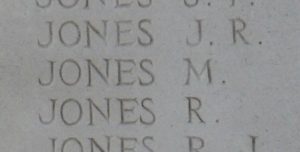
John Powell Jones, Lance Corporal, 2200, Royal Welsh Fusiliers. John was the son of John and Ellen Jones of Brynhir Terrace, Penmorfa. He married Jane Evans at Maentwrog on 10 September 1913 and the couple resided at Waterfield, High Street, Blaenau Ffestiniog, where their son was born. John enlisted at Blaenau Ffestiniog into the 7th Battalion, Royal Welsh Fusiliers. The battalion was a Territorial unit, which mobilised for war at Newtown in August 1914, as part of North Wales Brigade, Welsh Division and moved to Conway until the end of the month, before moving to Northampton. In December the Division moved to Cambridge and then in May 1915 to Bedford, where the Division was numbered and the formation became 158 Brigade, 53rd (Welsh) Division. On 19 July 1915 the entire Division sailed from Devonport for Imbros and on 9 August 1915 landed at Suvla Bay. The infantry moved off the beaches into the bush, but due to a lack of maps and no knowledge of the terrain, many of the units became disorientated, and the situation became chaotic. John was killed in action during heavy fighting the following day, 10 August 1915, aged 30. He is buried in Green Hill Cemetery, Gallipoli.
Pierce Edward Jones, Lance Corporal, 148018, Canadian Infantry. Pierce was born on 27 arch 1890, the son of Edward and Jane Jones, of Brynllech, Ffestiniog. He had emigrated to Canada with a brother, David, prior to the war and found work as a car repairer at Winnipeg. Pierce enlisted into the 38th Fort Garry Horse, Canadian Expeditionary Force at Winnipeg on 2 August 1915 and was posted to the 78th Battalion, Canadian Infantry. The battalion sailed from Montreal for England aboard the SS Corsican on 25 September 1915, and moved with the battalion to Shorncliffe. On 29 February 1916 Pierce embarked for France with a draft of men for the 10th Battalion, Canadian Infantry. The battalion was attached to the 2nd Brigade, 1st Canadian Division, and was in the Ypres Salient. Pierce saw his first major action when the Germans attacked Hill 62 and Mount Sorrel in June, when the 10th Battalion, in reserve, was sent forwards to take part in a counter-attack, helping recover the lost high ground. The Canadians then moved south to the Somme, relieving the Australians, and on 10 September 1916 the 10th Battalion took over trenches facing the Germans stronghold of Mouquet Farm. The 2nd Canadian Division launched a successful assault on Courcelette on 15 September, then the 1st Canadian Division launched an assault upon the Zollern Redoubt, Stuff Redoubt, and the Hessian trench system on 26 September 1916. Pierce was killed in action during the terrible fighting that day. The 26-year-old has no known grave and is commemorated on the Vimy Memorial, France.
Robert Henry Jones, Private, 54737, Royal Welsh Fusiliers. Robert was the son of Robert and Catherine Jones of Highgate, Ffestiniog. He worked as a farm servant at Bala prior to the war. Robert enlisted at Blaenau Ffestiniog into the Royal Welsh Fusiliers, and after completing his training was posted to France, joining the 10th Battalion, Royal Welsh Fusiliers, which was attached to 76 Brigade, 3rd Division. The Division saw heavy fighting at Ypres in February 1916, during the Actions of the Bluff. It remained in positions near Kemmel afterwards and during March and April took part in a series of Actions at the St Eloi Craters. Robert probably joined the 10th RWF after this, when the battalion had to be heavily reinforced, following heavy losses. The Division moved out of the Ypres Salient during the first week of June and began its move south to the Somme on 1 July, after a spell resting at Éperlecques. By 9 July the 10th RWF was in billets at Bronfay Farm, then moved into the Breslau Trenches on the 13th, before taking over Montauban Alley, and over the coming days took part in heavy fighting when the Division captured Longueval. The Division then took part in the Battle of Delville Wood, where two men of the 10th RWF were awarded the Victoria Cross. The battalion was relieved on 25 July and moved back into reserve to rebuild. On 16 August the Division moved back into the line, taking over Casement, Dublin and Chimpanzee Trenches, again suffering heavy casualties over the coming days. The Division then moved for a brief spell to the Noeux-Les-Mines sector, holding the line at Loos during September, before moving back to the Somme and took over the line at Serre on 12 November. On the following day, 13 November 1916, the Division launched an assault against the German trenches at Serre, but the 10th RWF out-ran the battalions on its flanks and came under attack from each flank, suffering heavy casualties. Robert was killed in action during the days fighting. The 27-year-old has no known grave and is commemorated on the Thiepval Memorial, France.
William Jones, Private, 20280, Royal Welsh Fusiliers. William was born in Southport, Lancs in 1896. He had been adopted by Thomas and Catherine Jones, of Pantyrhedyn, Ffestiniog. William married Jane Margaret Jones, of Ffestiniog in the summer of 1915, after having enlisted into the Royal Welsh Fusiliers. William embarked for France early in 1916, joining the 13th Battalion, Royal Welsh Fusiliers. The battalion was in the Fleurbaix sector, attached to 113 Brigade, 38th (Welsh) Division. The Division then held a sector of the line near Cuinchy before marching south to the Somme sector in June 1916 to take part in the assault on Mametz Wood. The first attack on the wood was launched on a two-battalion front on 7 July, but failed, and the Divisional Commander, Sir Ivor Philipps, was replaced before the Division attacked again on a two Brigade front on 10 July 1916. William was wounded during the early stages of the battle, and was evacuated to the Hospital at Heilly, in the Somme valley, where he died of his wounds on 12 July 1916, aged 20. He is buried in Heilly Station Cemetery, Mericourt-L’Abbe, France.
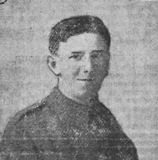
William Jones, Private, 3116, Non-Combatant Corps. William was the son of Thomas and Catherine Jones, of 22, Lord Street, Blaenau Ffestiniog. He worked as a Slate Maker prior to the war. William was a Conscientious Objector, and when he received his call up papers, he was posted to No 2, Aldershot Company, Non-Combatant Corps in October 1916. The Non-Combatant Corps was first established by Royal Warrant in March 1916 as a result of the Military Service Act 1916, which introduced conscription in Britain for the first time. The British Army had to form the Corps to provide a military unit for conscientious objectors who had been conscripted but were prepared to accept only non-combatant duties. The men of the Corps were trained and ran as ordinary soldiers, but without weapons, and were utilised as labour. William served for over two years in the Corps at Aldershot, but around the time of the Armistice took ill, and died of influenza at the Connaught Hospital, Aldershot on 18 November 1918, aged 40. His remains were brought home for burial in Llan Ffestiniog Cemetery. His brother, Thomas, was killed at Ypres on 31 July 1917. Neither man is commemorated on the Llan Ffestiniog memorial.
William Arthur Jones, Private, 26127, Royal Welsh Fusiliers. William was the son of Owen and Elizabeth Jones of Fron, Ffestiniog. He enlisted at Blaenau Ffestiniog into the 17th Battalion, Royal Welsh Fusiliers on 7 June 1915. The battalion was raised at Llandudno, joining 128 Brigade, 43rd (Welsh) Division and trained in North Wales before moving to Winchester in the summer of 1915, where the formation became renumbered 113 Brigade, 38th (Welsh) Division. The Division moved to France on 2 December 1915 and moved to the Nursery Sector near Fleurbaix for trench initiation alongside the Guards Division. During the last week of March 1916, the Battalion had been billeted in Gorre, undergoing various training courses. On 1 April the battalion moved into the Right Subsector Givenchy Line to begin a short tour in the trenches. After four days the battalion was relieved and moved into support and on 8 April was again relieved, moving back into billets. On 14 April the Battalion marched to Éstaires, and on the following day began another tour in a new sector, in the Fauquissart Sub Sector. William was the sole casualty suffered by the battalion during this latest four-day tour, being killed in action on 18 April 1916, aged 29. He is buried in Buried Royal Irish Rifles Graveyard, Laventie, France.
William Hugh Jones, Second Lieutenant, Royal Welsh Fusiliers. William was born at Llanelidan on 22 August 1888, the son of Thomas Owen Jones and Anne Catherine Jones. The family had moved to Clocaenog by 1901, and then to Bryn, Corwen. William had become a bank clerk at the London County and Midland Bank at Ffestiniog prior to 1911, and resided at Penallt. He enlisted into the 16th Battalion, London Regiment at some time after the outbreak of war, and on 7 February 1917 was commissioned as a Second Lieutenant into the 7th Battalion, Royal Welsh Fusiliers. After completing his training, William was posted to France, joining the 16th Battalion, Royal Welsh Fusiliers, which was in the Canal Bank Sector at Boesinghe, attached to 113 Brigade, 38th (Welsh) Division. On 3 March 1917 the 16th RWF was at work improving dug-outs and fortifications on the Canal Bank when William joined its ranks and was taken on strength. Over the coming weeks the battalion carried out the normal routine of rotation in the trenches, four days in the front, four in support and four in rest, all the while working on improving trenches, carrying supplies or training, as well as sending out regular patrols into No Man’s Land. On 21 June 1917, William was leading a working party from the battalion back from working in the trenches, when the Germans began shelling behind the lines. William was killed almost instantly by a piece of shrapnel which struck him in the head. The 28-year-old is buried in Bard Cottage Cemetery, Belgium.
Cuthbert Hayward Kirkus, Captain, Royal Garrison Artillery. Cuthbert was born on 8 June 1880, the son of William Miller Kirkus and Louisa Kirkus, of Liverpool. He was educated at Liverpool College, Sedburgh College and at St. Catherine’s College, Cambridge, graduating BA in 1902. He then became a Stockbroker, with homes at 4, Water Street, Liverpool; Madingley, Eastham, Cheshire; and at Brynhyfryd, Ffestiniog. Cuthbert married Ethel Blanche Rose on 7 June 1906. He enlisted into the 28th Battalion, London Regiment (Artists Rifles) following the outbreak of war, and was commissioned from the battalion into the Royal Garrison Artillery on 23 November 1916. Cuthbert was then posted to the 283rd Siege Battery, Royal Garrison Artillery, which was in the Ypres Salient. The Third Battle of Ypres was launched on 31 July 1917, and the 283rd Siege Battery was one of the many batteries supporting the infantry assault. Cuthbert was killed in action, probably by counter-battery fire, that day. He 37-year-old is buried in Kemmel Chateau Military Cemetery, Belgium.
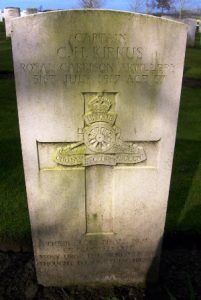
Evan Lewis, Private, 820, Non-Combatant Corps. Evan was the son of Lewis and Margaret Lewis of 17 Bowydd Street, Blaenau Ffestiniog. He worked as a Slate Maker prior to the war. Evan was a Conscientious Objector, and when he received his call up papers, he was posted to the 1/4th Western Company, Non-Combatant Corps at Kinmel Park on 2 April 1916. The Non-Combatant Corps was first established by Royal Warrant in March 1916 as a result of the Military Service Act 1916, which introduced conscription in Britain for the first time. The British Army had to form the Corps to provide a military unit for conscientious objectors who had been conscripted but were prepared to accept only non-combatant duties. The men of the Corps were trained and ran as ordinary soldiers, but without weapons, and were utilised as labour. Evan was transferred to No 2 Aldershot Company on 29 May 1916. He then served for over two years in the Corps at Aldershot, but around the time of the Armistice took ill, and died of influenza at the Connaught Hospital, Aldershot on 15 November 1918, aged 32. His remains were brought home for burial in Llan Ffestiniog Cemetery. Evan is not commemorated on the Llan Ffestiniog memorial.
James Lightfoot, Private, 26118, Royal Welsh Fusiliers. James was born in Sale in about 1875. He married Elizabeth Jane Williams at Conway Wesleyan Chapel on 21 March 1901. He was a labourer, living with Elizabeth at 4, Bryn Bowydd, Blaenau Festiniog, who had served with the Volunteer Corps when he enlisted at Blaenau Festiniog into the Royal Welsh Fusiliers on 3 June 1915. He was posted to the 17th Battalion, Royal Welsh Fusiliers, which was training in North Wales with the 38th (Welsh) Division and embarked for France with the battalion on 4 December 1915. James served in France for a year, taking part in the divisions assault on Mametz Wood in July 1916, before his health began to fail and he was posted to the Royal Welsh Fusiliers Depot Battalion on 4 November 1916 before being transferred to the 553rd Home Service Employment Company, Labour Corps on 30 June 1917. He served at home until being discharged from the army as medically unfit on 5 September 1918. James returned to Blaenau Festiniog where he died of heart disease on 17 March 1919, aged 45. His case was recently forwarded to the CWGC as a result of my research and he was accepted for commemoration by them on Wednesday, 3 February 2021. His name will be added to the United Kingdom Book of Remembrance until his grave can be located. James is not commemorated on the Llan Ffestiniog war memorial.
Robert Morris, Private, 2485, Royal Welsh Fusiliers. Robert was the son of Joseph and Jane Morris, of Club House, Ffestiniog. He had enlisted at Blaenau Ffestiniog into the 4th Battalion, Royal Welsh Fusiliers (Militia) on 29 January 1906, and then enlisted into the 7th Battalion, Royal Welsh Fusiliers. The battalion was a Territorial unit, which mobilised for war at Newtown in August 1914, as part of North Wales Brigade, Welsh Division and moved to Conway until the end of the month, before moving to Northampton. In December the Division moved to Cambridge and then in May 1915 to Bedford, where the Division was numbered and the formation became 158 Brigade, 53rd (Welsh) Division. On 19 July 1915 the entire Division sailed from Devonport for Imbros and on 9 August 1915 landed at Suvla Bay. The infantry moved off the beaches into the bush, but due to a lack of maps and no knowledge of the terrain, many of the units became disorientated, and the situation became chaotic. Robert was killed in action four days after the landing, on 13 August 1915. The 29-year-old has no known grave and is commemorated on the Helles Memorial, Gallipoli.
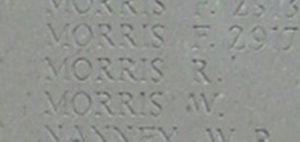
Griffith Owen, Private, 20268, Royal Welsh Fusiliers. Griffith was the son of William and Dorothy Ann Owen of Glanrafon, Lord Street, Blaenau Ffestiniog. He Enlisted at Blaenau Ffestiniog into the 17th Battalion, Royal Welsh Fusiliers, but after completing his training did not embark for France with the battalion, but remained at Kinmel Park for a time, before being posted to the 1st Battalion, Royal Welsh Fusiliers, which was in France attached to 22 Brigade, 7th Division. He probably joined the Division prior to the summer of 1916, when it was on the Somme, holding the line at Bois Francais. On 1 July 1916 the 1st RWF took part in the Divisions assault on Mametz village, one of the few successes of the opening day of the Somme offensive. The Division then fought at the Battle of Bazentin, and the Attacks on High Wood, playing a successful part in the dawn attack, before becoming the first troops into High Wood. The Division then took part in the Battle of Delville Wood, and the Battle of Guillemont, before spending the winter on the Ancre. Griffith was probably wounded around 9 January 1917, when the 1st RWF was supporting an assault by another battalion on Muck Trench. The British Artillery supporting the attack fell short into the front-line trenches held by the battalion, wounding a number of men who were sent to hospital. Griffith died of his wounds in hospital at Étaples on 19 January 1917, aged 23. He is buried in Étaples Military Cemetery, France.
John Thomas Owen, Private, 60386, Royal Army Medical Corps. John was the son of William and Ann Owen, of Bryntirion, Pant Llydd, Ffestiniog. He enlisted into the Royal Army Medical Corps soon after the outbreak of war, and was posted to the 16th Stationary Hospital, at Mudros, a port on the Greek island of Lemnos. The Hospital had been set up to deal with the inevitable casualties which would be suffered during the Gallipoli campaign. John arrived in Egypt on 21 August 1915, before embarking for Mudros to join the staff at the Hospital. The island of Lemnos was an important staging point for the Gallipoli campaign, and John would have found himself very busy during his time there. John had not been at Mudros long before he took ill, and died of disease on 29 November 1915, aged 38. He is buried in East Mudros Military Cemetery, Lemnos.
John Oscar Phillips, Rifleman, 47571, Rifle Brigade. John was the only son of Reverend Robert Talfor Phillips, Minister of Bethel Chapel, and Margaret Phillips, of Llwyn, Ffestiniog. He was a promising student, but when war broke out, he enlisted into the Royal Flying Corps. He then transferred to the Rifle Brigade, and was posted to the 2/10th Battalion, London Regiment, which was attached to 175 Brigade, 58th (London) Division. The Division embarked for France from 20 January 1917, and followed the German Retreat to the Hindenburg Line in March. It then took part in the Flanking Operations Round Bullecourt. Later that year the Division moved north to Ypres, and took part in the Battle of the Menin Road, the Battle of Polygon Wood and the Second Battle of Passchendaele. In March 1918 the Division was positioned around St. Quentin, and faced the German Spring Offensive of 21 March here, fighting at the Battle of St Quentin, and during the withdrawal towards Villers-Bretonneux. On 8 August 1918 the Allies launched a joint offensive, the Battle of Amiens, focused on the area around Villers Bretonneux, which broke German spirits, and on 21 August the Allies launched a full-scale offensive along most of the Western Front. The 58th Division had been in the centre of the fighting around Villers-Bretonneux, around the village of Chipilly, and now began to take part in the general advance from the direction of Morlancourt. John was killed in action when his battalion assaulted the German line from Trigger Wood to Bronfay Farm on 25 August 1918. The 18-year-old has no known grave and is commemorated on the Vis-en-Artois Memorial, France.
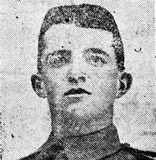
Arthur Price, Private, 16083, Royal Welsh Fusiliers. Arthur was born at Abergwynolwyn Police Station on 12 October 1888, the son of Police Constable Richard Price and Elizabeth Price. By 1901 the family had moved to Blaenau Ffestiniog, after his father had been transferred there. Arthur worked as a Butcher at Ffestiniog prior to the war. He enlisted along with his brother Thomas into the 16th Battalion, Royal Welsh Fusiliers soon after the outbreak of war. raised at Llandudno by the Welsh National Executive Committee from a cadre from the 13th Battalion, joining 128 Brigade, 43rd (Welsh) Division and trained in North Wales before moving to Winchester in the summer of 1915, where the formation became renumbered 113 Brigade, 38th (Welsh) Division. The Division moved to France on 2 December 1915 and moved to the Nursery Sector near Fleurbaix for trench initiation alongside the Guards Division. The Division then held a sector of the line near Cuinchy before marching south to the Somme sector in June 1916 to take part in the assault on Mametz Wood. The first attack on the wood was launched on a two-battalion front on 7 July, but failed, and the Divisional Commander, Sir Ivor Philipps, was replaced before the Division attacked again on a two Brigade front on 10 July 1916. After two days of brutal hand-to-hand fighting, the north edge of the wood was reached before the battered Division was relieved, and spent a month at Hébuterne before taking over the Canal Bank sector of the line at Boesinghe, north of Ypres. The infantry battalions of the Division then began the usual routine of rotation in the trenches, front line, reserve and rest over the coming months. On 5 October 1916 the 16th RWF relieved the 15th RWF in the front line to begin a routine spell in the trenches. Arthur was among a handful of men wounded over the coming days. He was evacuated back to the 46th Casualty Clearing Station at Proven, where he died of his wounds on 13 October 1916, aged 28. He was buried in Mendinghem Military Cemetery, Belgium.
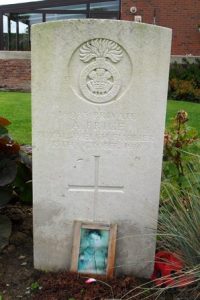
Humphrey Price, Private, 252633, Manchester Regiment. Humphrey was the son of David and Ann Price, of Bron Goronwy Farm, Cwm Cynfal, Ffestiniog. He worked for his father prior to enlisting into the army and was posted to the 5th Battalion, Manchester Regiment. Humphrey was training at Scarborough with the battalion, ready to embark for the front, and returned home on a short spell of leave a month prior to embarking for overseas. On 12 June 1917, Humphrey went up into the mountains with his brother to harvest peat, and decided to take a swim in Llyn Voelgron. Unfortunately, he got into difficulties, and despite his brothers’ best efforts, drowned. Humphrey was just 18 years old, and was buried a few days later. Nothing more is presently known of him, as he is not commemorated by the CWGC.
Hugh Lewis Roberts, Private, 40954, Royal Welsh Fusiliers. Hugh was the son of Margaret Phillips, of Cae Ffridd, Ffestiniog. He married Florence Davies on 3 September 1913, and the couple lived at Grove House, Llanberis. Hugh worked as a Quarryman prior to the war. He enlisted at Wrexham into the 3rd Battalion, Royal Welsh Fusiliers on 1 July 1916 and was posted to Litherland Camp, Liverpool for training. On 19 November 1916 Hugh embarked for France and joined No 5 Infantry Base Depot at Rouen. On 8 December 1916 he was posted to the 10th Battalion, Royal Welsh Fusiliers, which was attached to 76 Brigade, 3rd Division, but took ill soon after and was hospitalised, suffering from myalgia. Once he had recovered, he was posted back to No 5 Infantry Base Depot on 3 March 1917, and on 16 May 1917 eventually re-joined his battalion at Arras. On 12 June 1917 the battalion moved into the front line at Monchy and on the night of 13/14 June the battalion took part in an assault by 76 Brigade. The Germans counter-attacked on 15 June, but 76 Brigade stood firm and beat off the attack. On the following day the Brigades front line was shelled mercilessly by German artillery. Hugh was wounded in the head and evacuated to the 7th Field Ambulance, where his wound was dressed before he was taken to the 41st Casualty Clearing Station, before being sent to the 5th General Hospital at Rouen. Upon his recovery he re-joined the battalion on 19 October, but within weeks was hospitalised again, suffering from a severe case of Scabies. He was given two weeks leave in December 1917 and upon returning to France was hospitalised again with Scabies. On 9 April 1918 Hugh was posted to the 13th Battalion, Royal Welsh Fusiliers, which was at Bouzincourt Ridge, on the Somme, attached to 113 Brigade, 38th (Welsh) Division. On 22 April 1918 the 13th RWF took part in an operation to capture the high ground at Bouzincourt Ridge, but suffered severe casualties. Hugh had been wounded again, suffering gunshot wounds in the arm, and was evacuated from Rouen aboard the Hospital Ship SS St. Patrick, before being taken to the 3rd Scottish General Hospital, Glasgow. He had his arm amputated, but septicaemia set in, and he died of his wounds on 7 May 1918, aged 36. His remains were brought home for burial in Llan Ffestiniog Cemetery. He is not commemorated on the Llan Ffestiniog memorial.
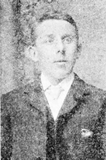
Owen Roberts, Private, 74165, Sherwood Foresters. Owen was the son of William and Laura Roberts, of Ffestiniog. He worked as a waggoner at Corwen prior to the war and married Elizabeth Ann Jones, of 3, Queen’s Square, Corwen on 5 February 1916. Owen enlisted into the 3rd Battalion, Royal Welsh Fusiliers at Wrexham on 30 January 1917, and was posted to Litherland Camp for training. On 19 September 1917 Owen embarked for France, and was posted to No 5 Infantry Base Depot at Étaples. He was posted from there to the 19th Battalion, Royal Welsh Fusiliers, which was attached to 119 Brigade, 40th (Bantam) Division. Owen was wounded during the Divisions attack on Bourlon Wood, during the Battle of Cambrai, on 24 November 1917, and was admitted to the 2nd Canadian General Hospital at Le Treport. Once he had recovered from his wounds he returned to the battalion, but it was disbanded on 6 February 1918, so Owen was posted to the 10th Battalion, Sherwood Foresters (Notts and Derby Regiment), which was attached to 51 Brigade, 17th (Northern) Division. On 21 March 1918 Owen’s new battalion was in the line at Hermies when the German Spring Offensive hit, and over the coming days fought a stubborn withdrawal towards Bouzincourt. The battalion then had a short rest before taking over a section of the front line near Mesnil on 15 April. Owen was badly wounded during a counter-attack here on 21 April 1918, and died of his wounds on the following day, 22 April 1918, aged 23. He is buried in Aveluy Wood Cemetery, (Lancashire Dump), Mesnil-Martinsart, France.
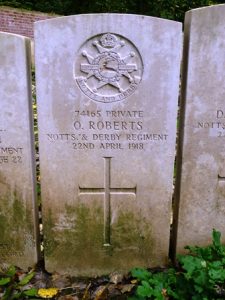
Thomas John Roberts, Private, 106760, Royal Army Medical Corps. Thomas was the son of Owen and Jane Roberts of Brynteg, Ffestiniog. He had been a member of St. John’s Ambulance prior to enlisting at Blaenau Ffestiniog into the Royal Army Medical Corps. He was posted out to Salonika, to join the staff of the 41st General Hospital, which was situated on the Monastir Road just to the west of Salonika. The Allies had sent a strong force out to Salonika following the conquest of Serbia, an ally of Britain, by a combined force of Austrian, Bulgarian and German troops. The Serbs had been pushed back towards Salonika, so the British and French rushed troops to the area, mainly troops from Gallipoli. The campaign was a trying one, with disease highly prevalent throughout both opposing armies. Medical staff were no exception, being exposed to the constant influx of sick and wounded men, and before the advent of penicillin, a large number themselves fell ill. Thomas contracted a fever during the Spring of 1918. He died of fever at the 41st General Hospital on 7 April 1918, aged 26. He is buried in Salonika (Lembet Road) Military Cemetery, Greece.
William Jones Roberts, Private, 21703, Welsh Regiment. William was the son of Edward and Alice Roberts, of Tyn-y-Maes, Ffestiniog. He had been working in South Wales prior to the war, and enlisted at Bridgend into the 13th Battalion, Welsh Regiment. The battalion was one of two raised in the Rhondda for the Welsh Army Corps, and was posted to Colwyn Bay, to join 114 Brigade, 38th (Welsh) Division. The Division assembled at Morn Hill Camp, Winchester in the summer of 1915 for final training prior to embarking for France early in December 1915 and moved to the Nursery Sector at Fleurbaix for trench initiation alongside the Guards Division. During June 1916 the Division moved south to the Somme, and on 7 July 1916 attacked Mametz Wood. The initial attack failed, and it was three days later, on 10 July, that a fresh attack was mounted. After two days of heavy hand to hand fighting within the wood, the Germans withdrew, and the battered Welshmen moved via Hébuterne to Boesinghe, on the Yser Canal, where it remained until launching its attack on Pilckem Ridge on 31 July 1917. The 15th Welsh remained in the line, and also took part in the Battle of Langemarck, before the entire Division was moved to positions near Armentieres over the winter. After the Germans launched their offensive on the Somme on 21 March 1918, the Division was moved back to the Somme, and took up positions north of Albert, around Aveluy Wood. During the first week of May the 13th Welsh was bivouacked at Hedauville, supplying working parties to the front. The battalion observed the calamitous assault on Aveluy Wood by the 15th Welsh on 10 May, when the battalion was forced to withdraw after its own artillery support fell short, causing around 150 casualties from ‘friendly fire’. William was wounded during this period, and died of his wounds at the 29th Casualty Clearing Station on 12 May 1918, aged 35. He is buried in Bagneux British Cemetery, Gézaincourt, France.
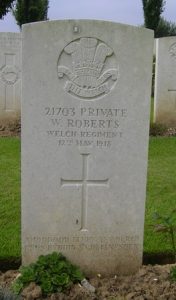
William Richard Roberts, Private, 4100, Royal Welsh Fusiliers. William was born in Trawsfynydd in 1887. He was initially adopted by Ellen Morris, a washerwoman, and lived at Church Street, Trawsfynydd, but by 1901 was living with his mother, Gwen Williams, at 6, Sun Street, Blaenau Ffestiniog. William enlisted into the 7th Battalion, Royal Welsh Fusiliers at Blaenau Ffestiniog on 27 November 1915. He had served overseas during the war, but his health had begun breaking down, and he had been transferred to the Labour Corps. On 29 November 1918 William was discharged from the army as medically unfit, and returned home to Ffestiniog, where he died of bronchitis on 13 September 1919, aged 33. He is buried in Llan Ffestiniog Cemetery.
David Lloyd Stoddart, Private, 14459, Royal Welsh Fusiliers. David was the son of Robert and Gaynor Stoddart, of Highgate, Blaenau Ffestiniog. The family had moved to 29, Sherwood, Llwynypia prior to the war, and David worked at the Glamorgan Colliery. He enlisted at Wrexham into the 11th Battalion, Royal Welsh Fusiliers soon after the outbreak of war. The battalion then moved to Seaford to join 67 Brigade, 22nd Division, and on 5 September 1915 the Division moved to France. On 30 October 1915 the Division embarked at Marseilles for Salonika, to join the Franco-British army being built up there following the fall of Serbia. The Division then took part in the retreat from Serbia during December 1915 and during August 1916 fought at the battle of Horseshoe Hill. During September the Division took part in the battle of Machukovo. The Division took part in the Battle of Doiran in April and May 1917, then in the Second Battle of Doiran on 18 September 1918. By now David had taken ill and been evacuated to hospital. He died of pneumonia at the 29th General Hospital, Salonika on 26 September 1918, just four days before Bulgaria surrendered. David was 28 years old and is buried in Mikra British Cemetery, Kalamaria, Greece.
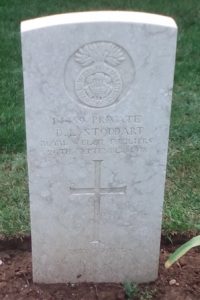
Daniel Thomas, Private, 26395, Royal Welsh Fusiliers. Daniel was the son of Daniel Thomas, of Barracks, Penybryn, Ffestiniog. He worked as a farm labourer prior to the war, and lived at Hafod yr Escob, Cwmtirmynach, Bala. He enlisted at Bala into the 17th Battalion, Royal Welsh Fusiliers on 22 July 1915, and was posted to Llandudno to join the battalion, which was training there, attached to 115 Brigade, 38th (Welsh) Division. The Division moved to Winchester in the summer of 1915, and Daniel embarked for France with the 17th RWF on 5 December 1915. The Division moved to the Nursery Sector near Fleurbaix for trench initiation alongside the Guards Division. It then held a sector of the line near Cuinchy before marching south to the Somme sector in June 1916 to take part in the assault on Mametz Wood. Following its efforts in clearing the wood, from 7 to 12 July, the Division was relieved, and had a short spell at Hébuterne before taking over the Canal Bank sector of the line north of Ypres. On 31 July 1917 the Division launched its assault on the Pilckem Ridge, and saw heavy fighting over the coming days. Daniel was wounded here on 5 August, being shot in the left leg, and was treated in Hospital in Boulogne before returning to England. On 17 February 1918 he arrived back in France, and was posted to the 2nd Battalion, Royal Welsh Fusiliers, which was attached to 115 Brigade, 38th (Welsh) Division. The Division moved to the Somme at the end of March, relieving the battered 2nd and 47th Divisions in the line north of Albert, and soon afterwards, Daniel was wounded again. On 20 June 1918, whilst home on leave, Daniel married Mary Edwards, of Bont-yr-Afon Garn, Ffestiniog. He returned to France, re-joining the battalion near Albert. Daniel was wounded soon afterwards, suffering gunshot wounds to his right thigh, and was treated at the 7th Canadian Stationary Hospital at Étaples, before re-joining the battalion again on 28 September. By now the Division was taking part in the great advance to the Hindenburg Line, and saw much fighting before taking part in its last major action, the Battle of the Sambre, on 4 November 1918. Daniel was killed in action during heavy fighting that day. He was 23 years old and is buried in Montay-Neuvilly Road Cemetery, Montay, France.
David Thomas, Private, 20464, Royal Welsh Fusiliers. David was the son of Ellis and Gwen Thomas, of Hafod Fawr, Blaenau-Ffestiniog. He lived at Tai Ucha, Corwen for several years prior to the war. David enlisted at Colwyn Bay into the 14th Battalion, Royal Welsh Fusiliers. The battalion was raised at Llandudno by the Welsh National Executive Committee, joining 128 Brigade, 43rd (Welsh) Division and trained in North Wales before moving to Winchester in the summer of 1915, where the formation became renumbered 113 Brigade, 38th (Welsh) Division. The Division moved to France on 2 December 1915 and moved to the Nursery Sector near Fleurbaix for trench initiation alongside the Guards Division. The Division then held a sector of the line near Cuinchy before marching south to the Somme sector in June 1916 to take part in the assault on Mametz Wood. The first attack on the wood was launched on a two-battalion front on 7 July, but failed, and the Divisional Commander, Sir Ivor Philipps, was replaced before the Division attacked again on a two Brigade front on 10 July 1916. David was killed in action during heavy fighting that day. The 24-year-old has no known grave, and is commemorated on the Thiepval Memorial, France.
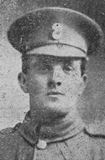
Evan Thomas, Private, 54764, Royal Welsh Fusiliers. Evan was born in Trawsfynydd in 1897, the son of Robert and Gwen Thomas. The family was residing at Tyn-y-Fedwen, Ffestiniog by 1911. Evan enlisted at Blaenau Ffestiniog into the Royal Welsh Fusiliers, and after completing his training, was posted to France, joining the 15th Battalion, Royal Welsh Fusiliers. The battalion had been raised in London, joining 113 Brigade, 38th (Welsh) Division, and had been in France since December 1915, taking part in the assault on Mametz Wood the following year. Evan would have joined the 15th RWF after its withdrawal from the Somme sector to the Canal Bank Sector at Boesinghe, north of Ypres, in August 1916. The infantry battalions of the 38th Division then began the normal routine of trench rotation, taking turns in the front line, support, then reserve, all the while carrying out improvements to the trenches, carrying out trench raids, and beating off German raids. On 17 June 1917 the 15th RWF was holding the Canal Bank line when it came under heavy fire by the German artillery, which caused 30 men killed and 60 wounded. Evan was among the men killed that day. The 20-year-old is buried in what amounts to a mass grave, in Bard Cottage Cemetery, Belgium.
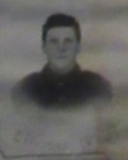
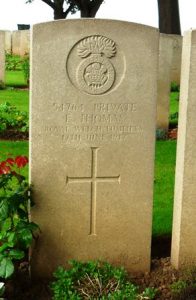
John Thomas, Private, 203457, Royal Welsh Fusiliers. John was the son of Owen and Catherine Thomas, of Tyn-y-Maes, Ffestiniog. He had married Sarah Evans in 1910, and the couple lived at Tan-y-Fron Terrace, Blaenau Ffestiniog, where their two daughters were born. John had enlisted into the 7th Battalion, Royal Welsh Fusiliers 9 June 1913, and had attended two Territorial summer camps prior to the outbreak of war. He did not embark for Gallipoli with the 7th Battalion, Royal Welsh Fusiliers in 1915, but remained with the Reserve Welsh Division at Bedford until being posted to the 4th Battalion, Royal Welsh Fusiliers, which was in France attached to the 47th Division as the Divisional Pioneer Battalion. During the Spring of 1916 the Division was north of Arras when the Germans attacked Vimy Ridge, and took part in the defensive operations which followed. The Division then moved south to the Somme, taking part in the Battle of Flers-Courcelette, and then at the Battle of Le Transloy, where the Division captured Eaucourt l’Abbe. The Division then took part in Attacks on the Butte de Warlencourt. Early in 1917 the Division moved north to Belgium, and took part in the Battle of Messines. It was moved south afterwards to take part in the Battle of Cambrai and fought in the Flesquières Salient following the German counter-attack. In March 1918 the Division was situated near St. Quentin, and the 4th RWF was carrying out work near Lechelles when the men could hear a heavy artillery barrage opening up along the front from the Scarpe to St. Quentin on 21 March. The barrage signalled the opening phase of the German Spring Offensive, and within hours the British front line had been smashed, and the Germans began to advance. The 47th Division took up positions along the Metz to Trescault road, and the 4th RWF began digging in. On the following day the Division began to withdraw, first to Highland Ridge then to Dessart Ridge, in face of the swathes of advancing Germans. The Division saw heavy fighting over the coming days as the British line was pushed back, and the 10th RWF crossed the River Ancre on 25 March. On 6 April 1918 the 10th RWF was ordered forward to take part in a counter-attack to the west of Aveluy Wood, and saw heavy fighting during the day, before being relieved. John had been killed in action at some time during the day. The 32-year-old is buried in Martinsart British Cemetery, France.
David Williams, Private, 2612, Royal Welsh Fusiliers. David was the son of William and Keturah Williams, of 11, Cromwell Street, Blaenau Ffestiniog. He enlisted at Blaenau Ffestiniog into the 7th Battalion, Royal Welsh Fusiliers. The battalion was a Territorial unit, which mobilised for war at Newtown in August 1914, as part of North Wales Brigade, Welsh Division and moved to Conway until the end of the month, before moving to Northampton. In December the Division moved to Cambridge and then in May 1915 to Bedford, where the Division was numbered and the formation became 158 Brigade, 53rd (Welsh) Division. On 19 July 1915 the entire Division sailed from Devonport for Imbros and on 9 August 1915 landed at Suvla Bay. The infantry moved off the beaches into the bush, but due to a lack of maps and no knowledge of the terrain, many of the units became disorientated, and the situation became chaotic. David was killed in action during heavy fighting on the following day, 10 August 1915. The 36-year-old has no known grave and is commemorated on the Helles Memorial, Gallipoli.
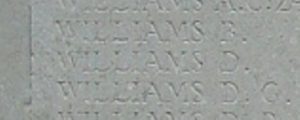
Philip Henry Woolford, Sergeant, 86950, Royal Engineers. Philip was the son of Alfred and Margaret Woolford, of Pen-y-Bont, Ffestiniog. He had moved to Hill Side, Upper High Street, Bedlinog by 1911 after having found work as a coal mine repairer. Philip enlisted into the Royal Garrison Artillery soon after the outbreak of war, but was afterwards posted to the 178th Tunnelling Company, Royal Engineers. He married Edith Mary Price, of Pontycymmer, whilst home on leave in the summer of 1916. He returned to France soon after his marriage, joining the 178th Tunnelling Company on the Somme. The Company had been at work there since July 1915, preparing for the forthcoming Somme offensive, and had excavated a group of mines known as Triple Tambour, beneath the German Kniewerk stronghold. Two of the mines were blown at 05.20 on 1 July 1916, while the third failed to explode. After its work at Fricourt, the Company began mining enemy positions in High Wood, blowing the mine on 9 September. Philip was awarded the Military Medal for Bravery in the Field during his time on the Somme, but was wounded soon afterwards and died of his wounds at the 38th Casualty Clearing Station, Heilly on 2 October 1916, aged 26. He is buried in Heilly Station Cemetery, France.
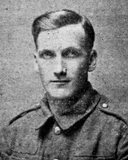
William Charles Wynn (Lord Newborough), Lieutenant, Welsh Guards. William was born at Tremadoc on 4 November 1873, the son of the Honourable Thomas John Wynn and Sybil Anna Catherine Wynn (nee Corbett), Lady Newborough. Upon the death of his father, William became the 4th Baron Newborough. He married Grace Bruce Carr in 1900 and the couple lived at 39, Park Lane, London and their Welsh home at Bryn Llewelyn, Llan Ffestiniog. William was commissioned into the Welsh Guards in the summer of 1915. The Regiment had been raised by Royal Warrant of 26 February 1915, at White City, before landing at Le Havre on 18 August 1915, becoming attached to 3rd Guards Brigade, Guards Division. The Division saw its first major action during the Battle of Loos, which began on 25 September 1915, remaining in the area during the coming months, where they also fought in the subsequent Action of Hohenzollern Redoubt. William joined the Welsh Guards in December 1915. He made an instant impact on his fellow officers: “Newborough was a big, dark man with a gentle voice and manner. So long as he had plenty of cigarettes, which he smoked through a beautifully coloured meerschaum holder, he was, if not happy, at least filled with smoke and philosophic resignation…” “I shall never forget old Newborough’s first experience of the line, I found him in Elgin Fort, where he had gone with an advance party. The dugout was filled with water, and only a sandbag table rose like an island from the centre of it. Sitting on the table was Newborough, his feet in the water, a cigarette in his mouth, and over him an air of complete resignation, as though he was saying, ‘This is my home for two days, and it can’t be helped.’” William was not with the battalion for much longer. The Guards Division moved to the Ypres Salient soon afterwards and held a section of the line near St. Jan Ter Biezen. He took ill soon afterwards and returned home for treatment, but died of pleurisy and general debility at his London home on 19 July 1916, aged 43. His remains were brought home to Ffestiniog and he was buried in a specially excavated grave on the Newborough Estate, Ffestiniog.
World War Two, 1939-1945
Dafydd Cynfal Davies, Sergeant, 2209857, Royal Air Force Volunteer Reserve. Dafydd was born in 1924, the son of William Llewelyn Davies and Jane Ellen Davies (nee Williams), 3, Belle Vue, Ffestiniog. He enlisted into the Royal Air Force Volunteer Reserve, and after training as an Air Gunner was posted to 224 Squadron, RAF, which was an RAF Coastal Command Squadron, based at RAF Milltown. On the night of 25 February 1945, Dafydd took off from Milltown aboard a Consolidated B-24 Liberator, Serial KG964 on a routine anti-submarine patrol around the Swedish coast. The Liberator crashed into the sea over the Skagerrack early the following morning, 26 February 1945, with the loss of all her crew of eleven, possibly due to anti-aircraft fire. The body of one of her crew, Joseph Gallipeau, was recovered and was buried in Varberg Church Cemetery, whilst the remains of Dafydd and nine other men were never recovered. Dafydd was 20 years old when he died that morning, and is commemorated on the Runnymede Memorial, Surrey.
David Wyn Davies, Lance Corporal, 4209993, Wiltshire Regiment. David was born on 22 March 1923, the son of Walter Davies and Annie Davies (nee Thomas) of 1, Bryn Tirion, Ffestiniog. He enlisted into the Army and was posted to the 1st Battalion, Wiltshire Regiment. The battalion was in India at the outbreak of war, carrying out garrison duties. It then became responsible for guarding the lines of communications and support for the Arakan offensive in Burma, becoming attached to the 4th Indian Infantry Brigade, 26th Indian Infantry Division, in October 1943. The Division took part in General Slim’s offensive to drive the Japanese out of Burma, but just before the launch of the campaign, the 1st Wiltshire’s were posted back to the North-West Frontier of India. David took ill after the battalion moved back into India, and died of jaundice on 31 January 1945, aged 21. He is buried in Rawalpindi War Cemetery, in what is now Pakistan.
Christmas Hughes, Aircraftman 2nd Class, 1667229, Royal Air Force Volunteer Reserve. Christmas was born on 25 December 1943, the foster-son of Margaret Anne Hughes, of 2, Tan-y-Bryn, Ffestiniog. He enlisted into the Royal Air Force Volunteer Reserve and was posted to 1680 Flight at RAF Abbotsinch, Scotland. On 3 July 1943, Christmas was flying aboard a Fokker F.XXII airliner, which was being used as a navigational training aircraft. The aircraft took off from Tiree on a flight back to Abbotsinch when it suffered an engine fire and crashed in West Loch Tarbert near Mull in Kintyre, killing all 20 passengers and crew aboard. Christmas was 20 years old when he was killed in the crash, and is buried in Campbeltown (Kilkerran) Cemetery, Scotland.
Humphrey Jones, Fusilier, D/14428, Royal Welch Fusiliers. Humphrey was the son of Robert and Gwen Jones of Bron Hyfryd, Llan Ffestiniog. He worked as a slate quarrier and married Mary Jones of Blaenau Ffestiniog in 1919. Humphrey had served during the Great War with the 7th Battalion, Royal Welch Fusiliers, and was still serving with the battalion at the outbreak of World War Two. He died on active service on 27 January 1940, aged 48, and is buried in Llan Ffestiniog Cemetery. Humphrey is not commemorated on the Llan Ffestiniog memorial.
Robert Owen Jones, Fusilier, 4205233, Royal Welch Fusiliers. Robert was the son of Robert and Kate Jones of Bryn House, Ffestiniog. He enlisted into the army and was posted to the 12th Battalion, Royal Welch Fusiliers. The battalion was formed in 1940 for Home Defence, until converting into the 116th Light Anti-Aircraft Regiment, Royal Artillery in January 1942, and then served with 53rd (Welsh) Division. Robert died on active service at Scarborough just prior to the battalion’s conversion, on 31 May 1941, aged 29. His remains were brought home for burial in Llan Ffestiniog Cemetery.
Eric Lloyd Owen, Fifth Engineer Officer, Merchant Navy. Eric was the son of John Llewelyn and Annie Owen of 21 Tyn-y-Maes, Ffestiniog. He enlisted into the Merchant Navy and trained as an engineer, becoming Fifth Engineer Officer aboard the oil tanker MV British Dominion. On 11 January 1943 she was en-route from Curaçao via Trinidad for Gibraltar, straggling behind Convoy TM-1, carrying a cargo of 9,000 tons of aviation spirit when she was sighted and torpedoed by the German submarine U-522 and damaged. The crew got off into the ship’s lifeboats, abandoning the ship, which was later sunk by the German submarine U-620. Of the 53 men aboard her, only 16 were rescued alive. Eric was 21 years old when he died following the loss of British Dominion on 11 January 1943. He has no known grave and is commemorated on the Tower Hill Memorial, London.